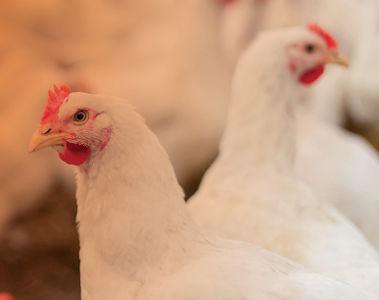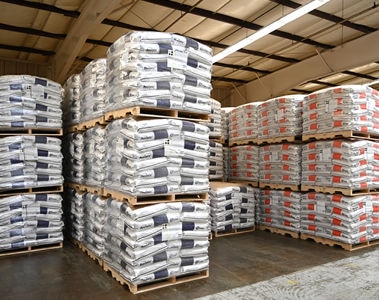
In Brief
The prevalence of leg weakness has been a growing concern in the poultry industry, it is estimated that 5.5 – 48.8% of birds have compromised gait (Hartcher and Lum, 2020). Lameness can result from a multitude of factors (Casaubon Huguenin and Brugère-Picoux, 2015, Shivaprasad, et al., 2013, McNamee and Smyth, 2000, Wideman, 2016) including:
The focus of this article is on dietary and bacterial challenges that can predispose birds to lameness. It is important to note that lameness is a progressive disease so with monitoring it can be reduced in a flock.
Dietary lameness
Proper bone development is central for structural integrity and muscle deposition which ultimately indicates meat yield. Calcium (Ca), phosphorus (P), and vitamin D3 (vit D3) are key players in mineralization as part of bone development. Ca and P are the structure, strength, and flexibility of the bone while vitamin D supports the transport of these minerals from the gut to the bone.
Dietary sources of these components are relatively inexpensive, but accurately providing the components to the bird at their requirements can be challenging. For example, digestible Ca has been topic receiving much attention due to a general oversupply of total dietary Ca (Walk, 2016) and associated detrimental effects on P and amino acid utilization and performance (Walk et al., 2021). It has been well documented that dietary Ca can form mineral-phytate complexes, ultimately impacting phytate degradation and P availability (Selle et al., 2009). Additionally, vit D3 can be supplemented in different forms. The inactive form of Vit D (cholecalciferol) can be produced in the skin or absorbed from the diet. It undergoes 2 hydroxylation steps to become hormonally active: 1) firstly, in the liver to 25-hydroxycholecalciferol (25-OH-D3) and 2) secondly, in the kidneys and intestine to 1α,25-dihydroxycholecalciferol (1,25-OH-D3). Once in the active form, it can support the absorption of Ca and P in the gut (Sakkas et al., 2019). Intestinal and/ or liver damage (by mycotoxins or other challenges) causes the inability for vit D absorption, directly impacting the bioavailability of nutrients for proper bone formation (Keçi, et al., 2019). Dietary 25-OH-D3 is absorbed more efficiently than cholecalciferol (Figure 1) and is more effective to improve skeletal health as indicated by gait score (Figure 2; Sakkas et al., 2019).
Figure 1. Partial supplementation of D3 with 25-OH-D3 numerically increased serum 25-OH-D3 (Adapted from Sakkas et al., 2019).
Abbreviations: LD (low level of D3; 1,000 IU/kg), MD (medium level of D3; 4,000 IU/kg), HD (high level of D3; 7,000 IU/kg D3), 25MD (medium level consisting of 1,000 D3+3,000 25-OH- D3 IU/kg)
Figure 2. Partial supplementation of D3 with 25-OH-D3 numerically reduced gait score indicating better ability to walk. (Adapted from Sakkas et al., 2019). Bristol scoring system from 0 (normal) to 5 (unable to walk); Scores ≥ 3 indicate lameness.
Abbreviations: LD (low level of D3; 1,000 IU/kg), MD (medium level of D3; 4,000 IU/kg), HD (high level of D3; 7,000 IU/kg D3), 25MD (medium level consisting of 1,000 D3+3,000 25-OH- D3 IU/kg)
Evaluating blood levels of Ca, P, and 25-OH-D3 can be indicators of skeletal health and having proper baseline data for these at each life stage it key. As an example, a broiler breeder producer was seeing increased mortality in young birds after feeding and suspected a P problem; however, after taking blood samples and comparing with the Verax™ reference database, the birds were experiencing low Ca. By incorporating oyster shells and 25-OH-D3, and improving ventilation, the producer avoided further losses.
Bacterial lameness
Wet litter can predispose birds to footpad dermatitis and hock burns which is associated with lameness (Granquist et al., 2019) and wet litter can be a result of dietary challenges. However, the most common lameness associated with bacteria is bacterial chondronecrosis with osteomyelitis (BCO). BCO lameness effects at least 1% of broiler production across the Americas, Europe, and Asia (Wideman, 2016). This lameness can lead to various production losses like lower body weight gain and increased condemnations (Granquist et al., 2019). For BCO to occur, bacteria travel from the gut through the bloodstream and reside in mechanical stress sites in the bone (Wideman et al., 2015). This type of lameness is exacerbated with a fast growth rate and poor intestinal integrity which allows for more bacterial leakage into the bloodstream.
Physiological stress and elevated serum corticosterone level can suppress the immune system allowing for more bacterial translocation across the intestine (Quinteiro-Filho et al., 2012). Poor intestinal integrity is also common with feed contaminated with mycotoxins. The 2023 dsm-firmenich world mycotoxin survey indicated that over 80% of poultry feed is contaminated with at least one mycotoxin, affecting the intestinal integrity of most commercial flocks.
Previously, providing a blanket antimicrobial or antibiotic growth promotors (AGPs) could mask the effects of poor intestinal integrity and function or a weak immune system. As AGPs have been reduced or removed from the poultry market for nontherapeutic purposes, there is an opportunity for a microbial imbalance (Adedokun and Olojede, 2019). Some bacterial strains are targeted as aggravators for BCO and may be present in parent stock, hatcheries, and throughout production. A few examples of bacteria that have been isolated from BCO lesions include Enterococcus spp. and Staphyloccocus spp (Gilley et al., 2014). Competitive exclusion throughout production using synbiotics (a combination of probiotics with prebiotics) has been shown to reduce the incidence of BCO (Figure 3; Wideman et al., 2012).
Figure 3. Male broilers reared on wire flooring in environmental chambers and fed either a control diet or the control diet with a synbiotic. Incidences of total lameness are shown by individual chamber (numbers 1–10) as well as with the chambers pooled by diet treatment. The lameness incidences for all chambers pooled by diet treatment differed significantly (P = 0.001) (adapted from Wideman et al., 2012).
Dietary interventions for lameness
The importance of good nutrition with data-driven decision-making can make a difference in improving welfare and reducing economic downsides. Distinguishing the nutritional and bacterial causes of lameness can help fine tune which mitigation strategy is best for the flock.
Adedokun SA, Olojede OC. (2019) Optimizing Gastrointestinal Integrity in Poultry: The Role of Nutrients and Feed Additives. Front Vet Sci 5:348. doi: 10.3389/fvets.2018.00348
Casaubon Huguenin MT, Brugère-Picoux J. (2015) Diseases of the Musculoskeletal System. In: Manual of Poultry Diseases. Brugère-Picoux J et al, eds. AFAS, 2015:448-459.
Gilley AD, Lester H, Pevzner IY, Anthony NB, and Wideman RF. (2014) Evaluating portable wire-flooring models for inducing bacterial chondronecrosis with osteomyelitis in broilers. Poultry Science 93:1354-1367. Doi: http://dx.doi.org/10.3382/ps.2013-03781
Granquist EG, Vasdal G, de Jong IC, and Moe RO. (2019) Lameness and its relationship with health and production measures in broiler chickens. Animal 13:2365-2372. Doi: https://doi.org/10.1017/S1751731119000466
Hartcher KM and Lum HK (2020) Genetic selection of broilers and welfare consequences: a review, World's Poultry Science Journal, 76:1, 154-167, doi: 10.1080/00439339.2019.1680025
Keçi M, Lucke A, Paulsen P, Zebeli Q, Böhm J, and Metzler-Zebeli BU. (2019) Deoxynivalenol in the diet impairs bone mineralization in broiler chickens. Toxins 11:352. https://doi.org/10.3390/toxins11060352
McNamee PT, Smyth JA. Bacterial chondronecrosis with osteomyelitis ('femoral head necrosis') of broiler chickens: A review. Avian Path 2000;29(4):253-270.
Quinteiro-Filho WM, Rodrigues MV, Ribeiro A, Ferraz-de-Paula V, Pinheiro ML, Sa LRM, Ferreira AJP, and Palermo-Neto J. (2012) Acute heat stress impairs performance parameters and induces mild intestinal enteritis in broiler chickens: Role of acute hypothalamic-pituitary-adrenal axis of activation. J. Anim. Sci. 90:1986–1994.
Sakkas P, Smith S, Hill TR, and Kyriazakis I. (2019) A reassessment of the Vitamin D requirements of modern broiler genetics. Poultry Science. 98:330-340. Doi: http://dx.doi.org/10.3382/ps/pey350
Selle PH, Cowieson AJ and Ravindran V. (2009) Consequences of calcium interactions with phytate and phytase in poultry. Livestock Science. 124:126-141. Doi: http://dx.doi.org/10.1016/j.livsci.2009.01.006
Shivaprasad, HL. Musculoskeletal Disorders. In: Avian Disease Manual, 7th ed. Boulianne M, ed. AAAP, 2013:209-211.
Walk CL. (2016). The influence of calcium on phytase efficacy. Animal Production Science 56: 1345-1349. Doi: https://doi.org/10.1071/AN15341
Walk CL, Romero LF, Cowieson AJ. (2021). Towards a digestible calcium system for broiler chicken nutrition: A review and recommendations for the future. Animal Feed Sci and Tech. 276:114930. Doi: https://doi.org/10.1016/j.anifeedsci.2021.114930
Wideman RF, Hamal KR, Stark JM, Blankenship J, Lester H, Mitchell KN, Lorenzoni G, and Pevzner IY. (2012) A wire flooring model for inducing lameness in broilers: Evaluation of probiotics as a prophylactic treatment. Poultry Science 91, pp. 870-883
Wideman RF, Blankenship J, Pevzner IY, and Tuner BJ. (2015) Efficacy of 25-OH Vitamin D3 prophylactic administration for reducing lameness in broilers grown on wire flooring. Poultry Science 94:1821-1827. Doi: http://dx.doi.org/10.3382/ps/pev160
Wideman, R. (2016) Bacterial chondronecrosis with osteomyelitis and lameness in broilers: A review. Poultry Science. 95(2):325-344.
18 September 2023
Not all products are available in all markets nor associated claims allowed in all regions (including but not limited to USA and Canada).


27 Jan 2025

27 Jan 2025
We detected that you are visitng this page from United States. Therefore we are redirecting you to the localized version.